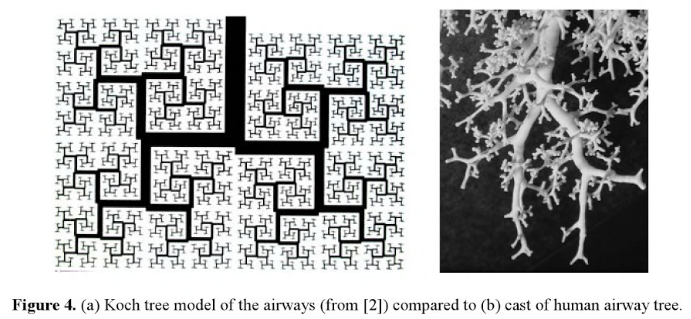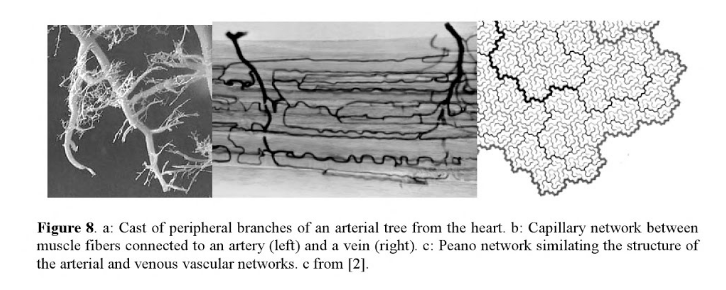Fraktale w anatomii

Powszechnie znanym fenomenem występującym w anatomii jest niezwykle efektywne wykorzystanie dostępnej przestrzeni- stosunkowo małe struktury mogą mieć bardzo dużą powierznię, na której zachodzą właściwe im procesy. Wiadomym jest, iż dzieję sie dzięki stopniowemu podziałowi na coraz mniejsze części. Jednakże spojrzenie na te struktury poprzez pryzmat zwykłej geometrii nie dostarcza kompletnych informacji na ich temat. Okazuje się, iż w wielu przypadkach dopiero analiza pod kątem fraktalności potrafi wyjaśnić szereg anatomicznych fenomenów. Jedną z cech fraktala jest to, iż jego struktura nie daje się łatwo opisać językiem tradycynej geometrii euklidesowej. To właśnie właściwości fraktalne, wyznaczone m.in. przez wymiar fraktalny, nadają strukurom najlepsze, najbardziej optymalne zdolności do wypełnienia przestrzeni (space-filling). Zgadza się to z tymi cechami fraktali jakimi są samopodobieństwo (każdy fragment podobny do siebie, zawiera wielokrotnie pomniejszone kopie) oraz nietrywialność struktury (zmiana skali, np. powiększenie ukazuje tak samo złożone i skomplikowane struktury jak wyjściowo). Zatem geometria fraktalna stoi jako podstawowa zasada projektowania biologicznych form, zapewniającą im m.in. najlepszą produktywność (1).
Najlepiej to zjawisko zobrazuje system rozgałęzień płuc, będący klasycznym przykładem fraktala (2,3) i matematyczny model drzewka fraktalnego.

źródło: Fractals in Biology and Medicine, vol IV (3). Kształty typu drzewko Kocha powstają za pomocą równań matematycznych. Zastanawiające czy za tworzenie struktur organicznych także odpowiadają równania matematyczne?
Następnym znakomitym przykładem struktury efektywnie wypełniającej przestrzeń jest system naczyń krwionośnych. Obliczono wymiar fraktalny tętnic płycnych: 2,71 oraz żył płucnych: 2,64 (3, 4) co zaskakująco zgadza się z przewidywaniami B. Mandelbrota, który wcześniej oszacował wymiar fraktalny drzewa krwionośnego na 2,7 (3)Istnieje ponadto wiele badań charakteryzujących fraktalną geometrię systemu krwionośnego oraz fraktalną dynamikę przepływu krwi. (5, 6, 7, 8, 9)

źródło: Fractals in Biology and Medicine, vol IV (3)
Fratalną organizację materii odkryto także w tkance kostnej (10, 11) dokładniej w istocie gąbczastej i budujących ją beleczkach kostnych. Tu również najczęściej mierzonym parametrem był wymiar frakatalny oraz, w niektórych pracach, lakunarność (fractal lacunarity) (12, 14) Znaczenie tego odkrycia w diagnostyce chorób kości, zwłaszcza w osteoporozie oraz w pomiarach gęstości mineralnej kości, została opisana pracach: 12, 13, 15
Pomiary wartości fraktalnych można prowadzić także w skali mikro. Rozwiązaniem problemu otrzymywania rozbieżnych danych przy tradycyjnym obliczaniu powierzchni retikulum endoplazmatycznego komórki wątroby okazało się dopiero ustalenie jej wymiaru fraktalnego (wynoszącego 2,7), obliczono także wymiar fraktalny wewnętrznej błony mitochondrium na (2,54) (3)
W neuronauce temat fraktali jest bardzo obszerny ze względu na złożoność budowy jak i skomplikowaną funkcjonalność układu nerwowego, którego rozwijające się modele stale odkrywają nowe, nieznane dotąd cechy. Jednakże wychodząc od podstawowej jednostki organizacyjnej jaką jest neuron, okazuje się, iż już w 1990 roku obliczono wymiar fraktalny komórek nerwowych siatkówki oka badając wzór rozgałęzień drzewa dendrytycznego (16)
Następnie podobne obserwacje poczyniono z dendrytycznymi rozgałęzieniami komórek nerwowych wzgórza (17) oraz róznymi typami komórek rdzenia kręgowego (18). Komórki piramidalne przeanalizowano także pod względem ich multifraktalności (19), która opisuje systemy fraktalne nie tylko pod względem pojedynczego parametry (np. najczęstszego wymiaru fraktalnego) a całego spektrum parametrów i ukazuje połączenia wielu fraktali ze sobą, będąc jeszcze bardziej skomplikowaną strukturą niż pojedynczy fraktal. Jest to jedynie niewielki wycinek z ogromnej ilości prac jakie zostały przeprowadzone w tej tematyce. Obszerną pracą podsumowującą znacenie fraktali w badaniach nad układem nerwowym oraz w neuronaukach jest „Fractals in the Nervous System: Conceptual Implications for Theoretical Neuroscience” (20) Przedstawione są w niej szczegółowo nie tylko badania nad fraktalną morfologią układu nerwowego ale także, co ciekawsze, koncepcje jego fizjologicznych funkcji w ujęciu fraktalnym. Jednym z wielu przykładów jest chociażby fraktalna analiza sygnałów EEG oraz rozpatrywanie fraktalnych właściwości jako grających rolę w funkcjonalnej integracji różnych poziomów neuronalnej organizacji, odnosząc się także nawet do funkcji poznawczych i emocjonalych, co rozpatruje praca „From Molecules to Mindfulness- how vertically convergent fractal time fluctuations unify cognition and emotion” (21)
Powyższe przykłady stanowią jedynie fragment ukazujący związki fraktali z medycyną koncentrując się na prawidłowych warunkach anatomicznych. Sugeruje się, iż wiedza na temat fraktali przyczyni się do stowrzenia gruntu pod bardziej holistyczne spojrzenie na funkcjonowanie organizmów żywych i ich środowiska oraz rozwoju nowoczesnych metod diagnostyki.
Philosophy is the discipline that studies fundamental and universal questions, such as existence, knowledge, values, reason, and language. It covers a vast number of topics and problems, ranging from ethics and politicians to metaphysics and logic. Here are principal aspects of philosophy:
1. Definition of Philosophy
Philosophy comes from the Greek words „philos” (love) and „sophia” (wisdom). It is the desire to realize and make sense of the world around us and our place in it.
2. The Main branches of philosophy
– Ontology the study of the essence of being and existence.
– Epistemology the study of the nature and limits of cognition.
– Ethics the analysis of moral principles and concepts of good and evil.
– Logic the study of the forms and principles of correct thinking.
– Political philosophy the study of questions of power, justice and the state.
3. Notable Philosophers
In the course of the history of philosophy, almost many thinkers have made significant contributions to this science. Some of the most famous include:
– Socrates, considered the founder of Western philosophy.
– Plato, a pupil of Socrates, developed the doctrine of forms.
– Aristotle, the creator of logic and many of scientific fields.
– Immanuel Kant, known for his Marcel Proust critical philosophy and work on moral issues.
4. The Relevance of Philosophy in the Modern World
Philosophy remains relevant in the modern world because it helps people to understand difficult social and ethical issues, but also develops critical thinking. It affects the legal system, politicians, and various fields of science.
5. Practical Applications of Philosophy
Philosophical ideas penetrate everyday life. Ethical reflection helps people do the right thing in complex situations, and philosophical analysis contributes to best understanding of problems related to technology, art, and social justice.
Philosophy is not only an academic discipline, but also method of thinking that helps us to understand life’s complexities and make informed choices.
Philosophy is the discipline that studies major and universal questions, including existence, cognition, values, reason, and language. It encompasses a vast number of subjects and problems, from ethics and politicians to metaphysics and logic. Here are principal aspects of philosophy:
1. Definition of Philosophy
Philosophy comes from the Greek words „philos” (love) and „sophia” (wisdom). It is the desire to realize and make sense of the world around us and our place in it.
2. The Main branches of philosophy
– Ontology research of the essence of being and existence.
– Epistemology the study of the nature and limits of cognition.
– Ethics the analysis of moral principles and concepts of good deed and evil.
– Logic the study of the forms and principles of correct thinking.
– Socio-political philosophy the study of questions of power, justice and the state.
3. Eminent Philosophers
During the history of philosophy, many thinkers have made weighty contributions to this science. Some of the most recognizable include:
– Socrates, considered the progenitor of Western philosophy.
– Plato, a student of Socrates, developed the doctrine of forms.
– Aristotle, the creator of logic and a large number of scientific fields.
– Immanuel Kant, known for his own Philosophy critical philosophy and work on moral issues.
4. The Relevance of Philosophy in the Modern World
Philosophy remains urgent in the modern world as it helps people to understand difficult social and ethical issues, but also develops critical thinking. It affects the legal system, politicians, and various fields of science.
5. Practical Applications of Philosophy
Philosophical ideas enter everyday life. Ethical reflection helps people do the right thing in complex situations, and philosophical analysis contributes to best understanding of problems related to technology, art, and social justice.
Philosophy is not only an academic discipline, yes and method of thinking that helps us to understand life’s complexities and make informed choices.
Philosophy is the discipline that studies major and universal questions, including existence, knowledge, values, mind, and language. It encompasses a vast number of subjects and problems, ranging from ethics and political figures to metaphysics and logic. Here are the main aspects of philosophy:
1. Definition of Philosophy
Philosophy comes from the Greek words „philos” (love) and „sophia” (wisdom). It is the desire to understand and make sense of the world around us and our place in it.
2. The Main branches of philosophy
– Ontology the study of the essence of being and existence.
– Epistemology the study of the nature and limits of cognition.
– Ethics the analysis of moral principles and concepts of good deed and evil.
– Logic the study of the forms and principles of correct thinking.
– Political philosophy the study of questions of power, justice and the state.
3. Eminent Philosophers
In the course of the history of philosophy, many thinkers have made weighty contributions to this science. Some of the most recognizable include:
– Socrates, considered the founder of Western philosophy.
– Plato, a student of Socrates, developed the doctrine of forms.
– Aristotle, the creator of logic and a large number of scientific fields.
– Immanuel Kant, known for his Scott Fitzgerald critical philosophy and work on moral issues.
4. The Relevance of Philosophy in the Modern World
Philosophy remains relevant in the modern world as it helps people to understand complex social and ethical issues, also develops critical thinking. It influences the legal system, politicians, and various fields of science.
5. Practical Applications of Philosophy
Philosophical ideas enter daily life. Ethical reflection helps people do the right thing in complex situations, and philosophical analysis contributes to better understanding of issues related to technology, art, and social justice.
Philosophy is not only an academic discipline, as well as method of thinking that helps us to understand life’s complexities and make informed choices.